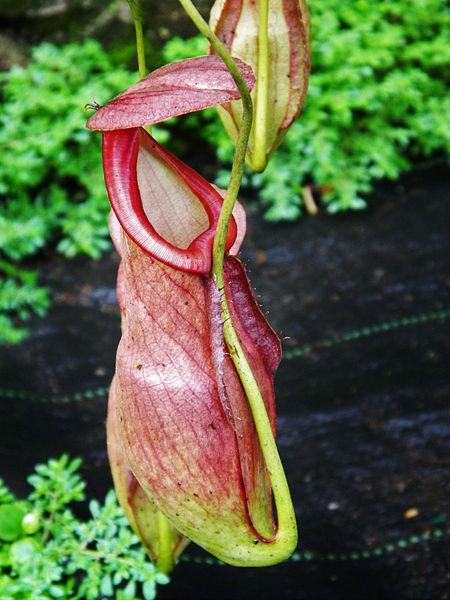Nepenthes attenboroughii, or Attenborough's pitcher plant, is a montane species of carnivorous pitcher plant of the genus Nepenthes. It is named after the celebrated broadcaster and naturalist Sir David Attenborough, who is a keen enthusiast of the genus. The species is characterised by its large and distinctive bell-shaped lower and upper pitchers and narrow, upright lid. The type specimen of N. attenboroughii was collected on the summit of Mount Victoria, an ultramafic mountain in central Palawan, the Philippines.
Nepenthes attenboroughii
The rosette (juvenile) pitchers of N. attenboroughii demonstrate the typical bell shape of this species when only a few inches high
A lower pitcher of N. attenboroughii supporting a large population of mosquito larvae
Nepenthes is a genus of carnivorous plants, also known as tropical pitcher plants, or monkey cups, in the monotypic family Nepenthaceae. The genus includes about 170 species, and numerous natural and many cultivated hybrids. They are mostly liana-forming plants of the Old World tropics, ranging from South China, Indonesia, Malaysia, and the Philippines; westward to Madagascar and the Seychelles (one); southward to Australia (four) and New Caledonia (one); and northward to India (one) and Sri Lanka (one). The greatest diversity occurs on Borneo, Sumatra, and the Philippines, with many endemic species. Many are plants of hot, humid, lowland areas, but the majority are tropical montane plants, receiving warm days but cool to cold, humid nights year round. A few are considered tropical alpine, with cool days and nights near freezing. The name "monkey cups" refers to the fact that monkeys were once thought to drink rainwater from the pitchers.
Nepenthes
Nepenthes mirabilis at the Periyar Tiger Reserve, in Southern Western Ghats of India
Nepenthes from Carolus Linnaeus's Species Plantarum of 1753
A drowned lizard found in a freshly opened pitcher of N. rajah







